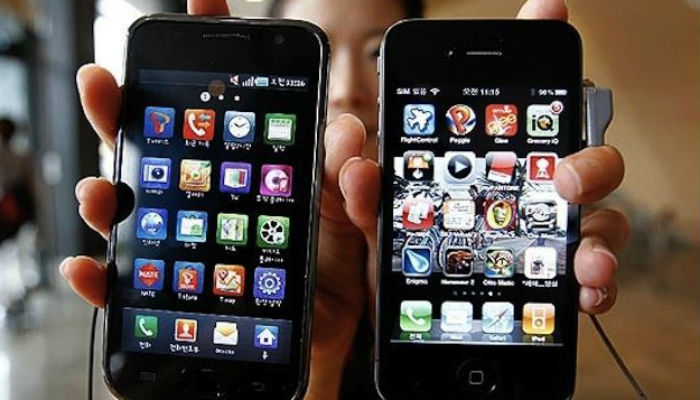Apple-Samsung iPhone design copying case goes to jury
Apple is seeking slightly more than a billion dollars in damages, while Samsung wants a figure closer to $28 million
May 20, 2018

Jurors return to a Silicon Valley courtroom Monday to put a price on patented iPhone design features copied by Samsung in a legal case dating back seven years.
Apple is seeking slightly more than a billion dollars in damages, while Samsung wants a figure closer to $28 million.
The jury has been asked to determine whether design features at issue in the case are worth all profit made from Samsung smartphones that copied them or whether those features are worth just a fraction because they are components.
"Samsung isn´t saying it isn´t required to pay profits," Samsung attorney John Quinn said during closing arguments on Friday.
"It is just saying it isn´t required to pay profits on the whole phone."
The three design patents in the case apply to the shape of the iPhone´s black screen with rounded edges and a bezel, and the rows of colorful icons displayed.
Samsung no longer sells the smartphone models at issue in the case.
Two utility patents also involved apply to "bounce-back" and "tap-to-zoom" functions.
"This is a case that is focused on design, and the application of design to smartphones," Apple attorney Joseph Mueller said in closing arguments.
When one company copies a rival´s design, that "is not a level playing field, and that is just not right," he contended.
Apple argued in court that the iPhone was a "bet-the-company" project at Apple and that design is as much the "article of manufacture" as the device itself.
Apple attorney Bill Lee equated the notion to a carmaker copying the look of the Volkswagen Beetle and coming to market with a competing model.
Determining whether the design features qualify as the "article of manufacture" will be key to whether jurors award the profit from all the Samsung phones involved, according to legal standards presented by the court.
The case dates back seven years. An original trial finding that Samsung violated Apple patents was followed by lengthy appellate dueling over whether design features such as rounded edges are worth all the money made from a phone.
Technology vs Style
Samsung, which had been ordered to pay $400 million, challenged the legal precedent that requires the forfeiture of all profits from a product even if only a single design patent has been infringed.
The US Supreme Court in 2016 overturned the $400 million patent infringement penalty imposed on the South Korean consumer electronics giant.
Justices ruled that Samsung should not be required to forfeit the entire profits from its smartphones for infringement on design components, sending the case back to a lower court.
The ruling found that the penalty -- one element of a major patent infringement case -- was inappropriate because it represented "Samsung´s entire profit from the sale of its infringing smartphones" for copying the iPhone´s "rectangular front face with rounded edges and a grid of colorful icons on a black screen."
The key question of the value of design patents rallied Samsung supporters in the tech sector, and Apple backers in the creative and design communities.
Samsung won the backing of major Silicon Valley and other IT sector giants, including Google, Facebook, Dell and Hewlett-Packard, claiming a strict ruling on design infringement could lead to a surge in litigation.
Apple was supported by big names in fashion and manufacturing. Design professionals, researchers and academics, citing precedents like Coca-Cola´s iconic soda bottle.
The Supreme Court stopped short of delving into details of how the lower court should determine how much phone design components are worth when it comes to patent infringement violations.
Presiding US District Court Judge Lucy Koh gave jurors in her San Jose courtroom a four-factor test to determine an "article of manufacture," but it is up to the panel to decide how the evidence fits that framework.
The case is one element of a $548 million penalty -- knocked down from an original $1 billion jury award -- Samsung was ordered to pay for copying iPhone patents.











